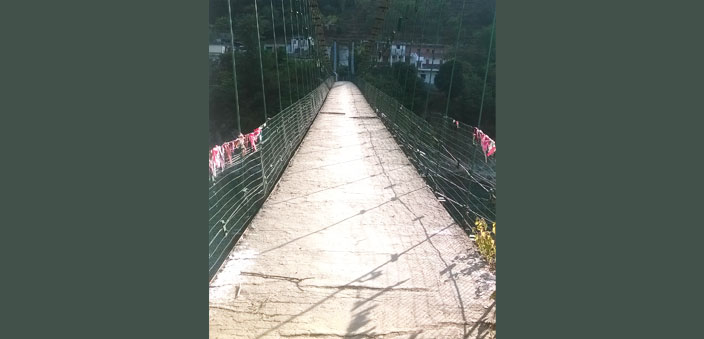Text and photos: Text: Anvi Mehta
Adistrict in the Kumaon part of Uttarakhand, Champawat, is in the southern most region of the state, and shares a border with Pittoragarh and Nainital. It also shares a border with Nepal, with the River Kali dividing them. There is every day movement of people between both sides for work and business.
Almost seventy-five per cent of the district is in the mountain ranges, making it a little inaccessible for tourists. But, it is also one of the less explored places, the raw pahadi culture can be observed in its villages. From the district, the Panchachuli ranges of the Himalayas are visible, they form a protective wall for the hilly terrain.
History of Champawat
The Champawat district was constituted in the late 1990s, but it was one of the major centres in the medieval times. Ruled by the Chand dynasty, the district was a major commercial centre, and a connect between India and Nepal. When the British invaded India, the Chands were defeated by the Nepal rulers, who had taken over a large portion of Kumaon.
The Chand rulers took help from the British to push away the Gorkhas, it was difficult for them to win a war against the furious Nepali rulers. Since then, a British influence has been observed in the hills. Champawat also has a hill station which was mainly inhabited by the British.
Champawat is a part of Kumaon, hence it follows the culture of the pahadis. Apart from the district centre where all the administrative heads have their work place, Lohaghat is another major centre. Though none of the towns are very developed, they are undergoing urbanisation.
Due to its proximity to Nepal, the Kumaoni dialect and culture is similar to that of the Nepalese. Farming and dairy are the primary sources of income, and people still follow the old practices of organic farming. One can often find women working in the fields, collecting fuel wood and fodder from forests. The men are either drivers or labourers.
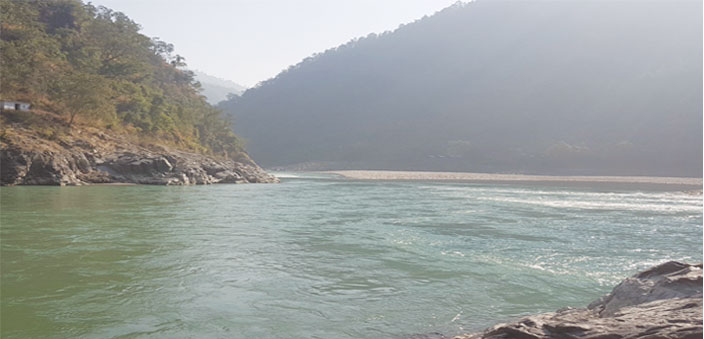
But a peculiar thing of the existing population is that most of them are immigrants from neighbouring districts or Nepal. They have been living here for 12-14 generations now, but their original roots belong to some other place. Major groups found here are Brahmins and Thakurs; they live together in clusters.
The culture of Champawat
Hinduism is the most followed religion here. Hence, the Hindu festivals are celebrated with grandeur in these regions. Champawat is famous for the number of temples, especially the Lord Shiva temples situated deep inside the forests. Purnagiri, Baleshwar temple and Gwal Devta are the major temples in the district. Holi, Navratri and Diwali are the major festivals, celebration of which takes place for weeks together. Villagers gather in their respective temples, sing songs, offer prayers and perform rituals to please the deities. They believe that anything which displeases the Gods could harm them and the future generations to come. Often, animal sacrifices, mainly goats, are done to get work done.
A tourist destination
Champawat is known for two reasons – temples and tigers. The very first tiger that Jim Corbett killed was in the district of Champawat. Man eaters were a regular feature in the area until the forests started to reduce, and illegal poaching decreased the population of these tigers. Though Champawat is known for its temples, it also has a few off beat places that one can visit. As there is not very heavy snowfall and summers are also relatively pleasant, the district can be visited any time of the year. It is still not developed as a tourist destination; hence, it is bliss for travellers who do not like crowded places. However, it is tough to find a decent hotel or a resort, but one can always get a village home stay, which is a better experience in a lot of ways.
During our visits to the district, we made a list of a few off beat places where one can live with nature, in pollution-free and non-commercial surroundings. These places are quiet and calm, everything that one needs if one wants a break from the chaos of city life.
The Banasura Killa
We start the list with the fort which is 20 kilometres from Champawat district centre and seven kilometres from Lohaghat. The fort was built in the medieval era, in the name of Banasura, the demon with a thousand arms.
The mountains have a tale for every place, this one has its own myth. In the Hindu scriptures there is a mention of a demon named Banasura. He ruled the Champawat region and was an ardent follower of Lord Shiva. To please the God, he followed strict penance. As a result, he was offered a boon. He asked for a thousand strong arms to defeat all his enemies and he received it immediately.
Though Banasura used it for defeating his enemies, soon, he started torturing his subjects. Power comes with great responsibility, but Banasura could not handle his responsibilities well. It is then that Lord Krishna, Vishnu’s incarnation, took it on himself to kill the demon. It is said the demon was killed at the very place where the fort now stands.
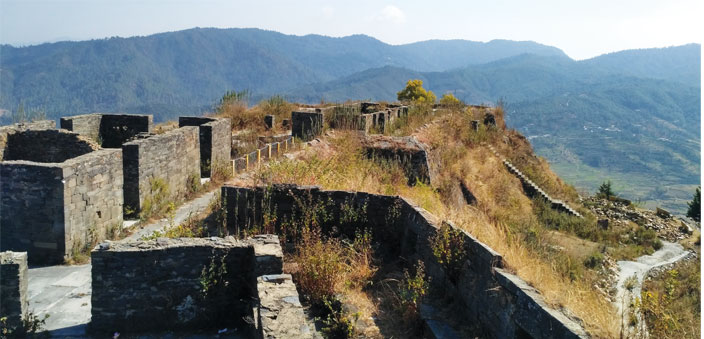
This tale was intriguing enough for us to go on a three kilometre trek. The trek was easy. There are certain points from which the origin of Lohaghati River is visible, and the mountains and valleys look gorgeously beautiful. On top of the peak, the fort ruins take you back to the time when it was constructed. The large stone boulders form a boundary wall, inside which are broken structures of the fort. It must have been a masterpiece in its full glory. With the view from the fort, it is by far the best place to visit in the district.
From the top, one can see the mountains and the Himalayan peaks on one side and the lush green villages on the other side. The best time to visit the fort is early in the morning. On a clear day, the Himalayas look serene and huge. Unfortunately, we reached a little late, so could not see the snow clad mountains, but the view was pretty amazing even then.
The Reetha Sahib
One of the pious places for Sikhs, Reetha Sahib is approximately 60 km from Champawat. It has a gurudwara at the meeting point of two rivers originating in the Himalayan ranges. All year round Sikhs visit this place of pilgrimage.
The Reetha Sahib is named after the soapnut tree, which bears a bitter nut commonly called Reetha. As per the local folk lore, Guru Nanakji had visited the place with Bhai Mardana to meet the Nath Yogis. Guru Nanakji was seated under a Reetha tree; he was speaking with the Yogis to show them a path of living a good life. Bhai Mardana felt hungry but had nothing to eat except for the soap nut fruits, which were bitter. This is when Guru Nanak plucked the soap nuts from his side of the tree and gave to Bhai Mardana to eat. It is said that he miraculously turned the bitter tasting soap nuts to sweet tasting fruits that could satiate anyone’s hunger. Though the original tree under which Guru Nanakji sat, does not exist anymore, his followers have planted new ones from the seeds of the older trees. The gurudwara still hands out sweet tasting Reetha as prasad to the pilgrims. The gurudwara is situated at the river bank, so one can spend some time near the waters as well. While monsoon is the best time to visit as the rivers flow and the weather is very pleasant, one can be here at any other time as well.
The gurudwara has a langar which serves hot Kumaoni-style chullah cooked food and tasty tea all day long. They also let you help in the kitchen and do seva if one is interested. It is highly recommended to stay for a day at Reetha Sahib. One has to attend to the evening bhajan and watch the sun rise by the river. And to experience the Sikh culture, a fair is set up during May and June, when Sikhs from all over visit the gurudwara. There are celebrations throughout, langars start from Lohaghat itself, the community serving free food and refreshments to passersby. The Reetha Sahib is a very serene experience in itself. En route the place are a few small waterfalls and lakes, where one can take a pit stop and enjoy the nature. But, you will need your own vehicle or you will have to rent a car to reach Reetha Sahib, as the frequency of buses is very less, and is also unreliable.
Pancheshwar
Again at the Nepal border, lies a small town called Pancheshwar. It is at the confluence of Kali River and Saryu River. Located 40 km from Champawat, reaching the place is quite a task as the roads are very narrow and no buses run from there. The place has a temple of Chammu Jaat, the God who protects animals. Offerings of milk and bael leaves are made, and the temple is dedicated to Lord Shiva.

The raw and untouched beauty of the surroundings makes it a picturesque place to visit. The best part of the place is the confluence of the two rivers; while one side is in India, the opposite side belongs to Nepal. Just crossing the river can take you to a foreign land! The place is abuzz with pilgrims during Navratra and Mahashivaratri when there are religious fairs organised here. The place also has a hermit living in a small hut of his own, if one gets a little chatty with him, he will make you tea laced with some bhang!
One cannot stay for long at Pancheshwar as there is no place to stay. If you are comfortable living in a tent, then camping by the river banks and spending the evening singing songs around a bonfire is a must. Otherwise, reach there early morning, enjoy the natural beauty and leave by afternoon. Also, there is no restaurant in the whole place, either pack your food or convince a villager to cook a meal for you.
The haunted Abott Mountain
A place developed by a British gentleman John Abott, hence the name, Abott Mountain is one of the highest peaks in the district and is a pleasant place to be in. It has a good view of the valleys and the Himalayan peaks of Trishul, Nanda Devi, Nanda Ghunti and Nanda Koi. It also has the second highest cricket pitch after Chail in Himachal Pradesh.
When John Abott discovered this place, a small Christian community was developed here. There were a couple of cottages, a hospital and a church built. The families lived here in harmony with the locals and everything was fine, for a while.
It is said that a doctor settled here a few years later and worked in the hospital. While some say he could foresee the future and predict a patient’s death, he shifted terminally ill patients to a special ward known as the Mukti Kothri, where they did die as prophesied. Some believe that he started going crazy with weird ideas of life after death, and that he performed bizarre experiments to create a living dead. He wanted to create his own Frankenstein. Soon, there were rumours of mysterious incidents and supernatural presence. The locals say the spirit of the patients who died an untimely death haunt the place. There is a church here, which is also closed currently, and prayer meetings are held once or twice a year. Listed as one of the most haunted places in India, the Abott Mountain is a must go for people interested in researching supernatural activities. Though there are cottages being developed there, as of today, there is no proper place to stay.
The Ek Hathiya Naula
Champawat, as mentioned earlier, was once ruled by the Nepalese. It is during those times that art and culture was at its peak. The Gorkhas wanted their structures to be constructed in the most unique ways, so they trained artisans to create masterpieces.
But, there was a rider to this. The artisans were punished once they completed a structure. One of their hands was cut off by the Nepali rulers so that they would not be able to replicate the art piece. Beating these odds, an unnamed artist constructed a naula (a small well like structure being the source of water in the mountains). He constructed it with the help of his daughter. The daughter carried the stones for her father. While the father used his chisel to carve the stone, the daughter hammered the stones as per instructions. Together, they made a beautiful piece of heritage which is located in the interiors of the forests, three kilometres from Champawat. The naula is known as Ek Hathiya as it was made by the artist using only one hand.
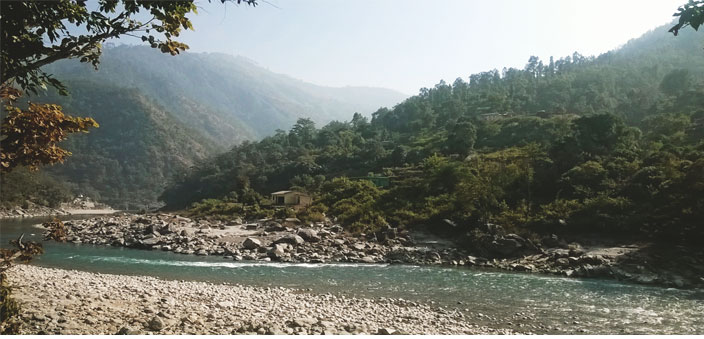
The naula is no less than any of the heritage sites in our country famous for its sculptures and stone carvings. Yet, it is not a very touristy destination and only a few locals know about it. It is a two to three hour long trek where one can also enjoy the forest. The best season to go to the naula is during the winter and the summer months, monsoon trek gets difficult because of the forest.
While most of the naula is intact, mischievous local goons have damaged some of the carvings. This place is heritage, yet it is not conserved well. Increase in tourism might just force the government to keep the heritage intact.
The 100-year-old water mill
Now that we have electronically running wheat grinders, the world has almost forgotten about the water mills that once were used to grind grains to make flour. Champawat district is home to one such water mill which was established by a family a 100 years back.
The water mill is located in the Dhamisaun village, 10 km from the district centre. The Joshi family had installed the water mill for the villagers. It was to reduce the burden of women who used to travel far to get their flour ground. Though at that time water mills were found in abundance, now due to scarcity of water and availability of better technology, this is the last one in the district.
Even now, villagers go to the mill and grind their grains without paying anything. Krishnanand Joshi, 55, is the fourth generation taking care of the mill. He uses his own money to get the mill cleaned and maintain the machine. He claims that once someone eats rotis made from the flour ground here, they will not find any other flour tasty.

Though this is not the usual tourist thing to do, but visiting places like this helps in experiencing the place for what it is. Also, the village of Dhamisaun is the rural India that one should definitely know about. It is situated amidst mountains and has no proper road system. Hence, the water mill still works as a drudgery reducer for women in this locality.
The cluster of temples
The pahadi people are very religious. They believe in Lord Shiva and Goddess Durga the most, they have temples dedicated to them but have local names for these gods. One can find a temple situated in the forests at the top of a peak in almost every part of the district. While covering all of them is not possible, but Purnagiri and Phataksheela are two recommended temples.
The Purnagiri temple is famous and visited by pilgrims from all over the country. It is located 70 km from the district centre and is close to the river Chalthi, which is another place of scenic beauty. To reach Purnagiri, one has to trek for about two to three hours. From the peak are visible a few mountain ranges of Nepal. The Phataksheela on the other hand, is a small temple, 30 km from Champawat district centre. It is said that a part of the linga from Purnagiri fell at this place, hence making it equally important to the locals.
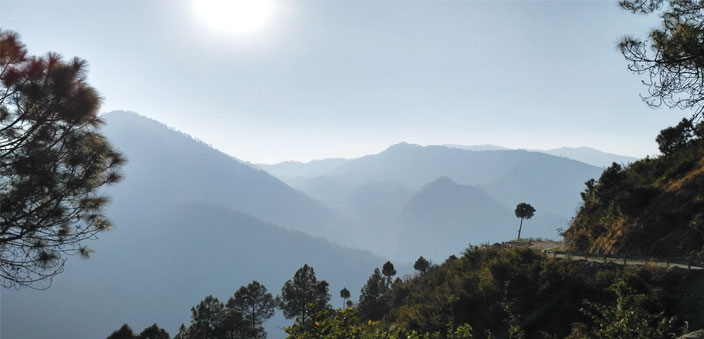
Other temples to visit are the Gwala Devta temple in the district centre, and Baleshwar temple which was constructed by the Chand rulers.
The temples in the pahads are much different from the ones in the plains. They have a fantastic view of the Himalayas, they are located in dense forests, and they are always ringing loud with the hundreds of bells tied by pilgrims. The best time to visit the temples is during festivities like Shivratri, Holi and Navratri. A few temples also serve bhang as prasad, a treat for all the weed lovers out there!
These are a few off beat places to visit in Champawat. The district has 600 plus villages and a village stay is one of the best decisions you would make if you decide to visit the place.

